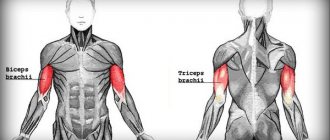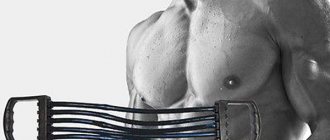Home / Exercises
Back
Published: 07/19/2019
Reading time: 4 min
0
451
Stretching helps to correctly form the muscle corset, posture and relax the back. This is especially important for a sedentary lifestyle, sedentary work, and some diseases of the spine. Stretching the lumbar region can be done using special devices or a set of exercises. The latter option is more effective, as it allows you to study independently at a time convenient for the person. However, before performing the complex, you must consult a doctor.
- 1 Stretching Basics
- 2 Contraindications
- 3 Types of exercises
- 4 Complex for pain
Why do you need stretching?
Each of us feels the benefits of civilization, which deprive us of a sufficient amount of movement. We are sitting at the computer, in a not very comfortable position. You yourself have probably noticed how stiff your neck and shoulder girdle are. We move by transport, public or private. We spend our evenings in front of the TV. And even simple stretching brings relief to the body. And if you do stretching correctly and regularly, then:
- the body will be in good shape;
- recovery processes in the body will improve, as blood flow will accelerate;
- Nervous tension is relieved by stretching and relaxing muscles;
- spine mobility improves;
- Pain in the neck and lower back decreases and goes away.
Even 5 to 15 minutes of stretching a day will bring tangible results within a week. And, most importantly, such exercises do not require a gym; you can do them at home yourself at a time convenient for you.
Stretching Basics
Stretching is done very carefully so as not to damage the spine. Before performing, you must first warm up your muscles. This can be done with massage, rubbing, or a warm bath. Without this, you can provoke rupture of muscles and tendons. Other stretching rules:
- The exercises are performed strictly according to the doctor’s regimen. Loads should increase gradually. Overexertion of the back and sudden stretching can cause pain and worsen the condition.
- Positive dynamics occur after at least 1.5-2 months of training. Moreover, with regular exercise (daily for 20 minutes) at least three times a week.
- Movements should be smooth, slow, without jerking.
- Exercises in the “lying down” position can cause discomfort or back pain due to contact with a hard surface, but the complex cannot be performed on a soft mattress either. Better on a special gymnastics mat. It is also necessary if training takes place on a cold floor or in winter.
- Exercises are not performed if there is pain in the lower back. If it starts during training, then the training is stopped immediately.
- It is important to monitor your breathing while stretching. You need to combine even exhalations and inhalations, and hold them when indicated in the instructions.
- Exercises cannot be selected independently. Often lower back pain is caused by intervertebral hernia, kidney stones, and gynecological diseases. And then stretching becomes dangerous.
The advantage of a set of exercises is that they can be performed at home at any convenient time. Over the course of a week, you will not spend more than two hours in total.
Stretching rules
When performing back stretching exercises at home, you must follow certain rules so as not to harm yourself.
- The first thing is to warm up the muscles. Cold muscles are difficult to stretch. To make stretching pleasant and painless, you need to warm up the body a little. To do this, you can perform 10-20 squats (you can rest your hands on the back of a chair), march for a couple of minutes, raising your legs high and swinging your arms. Or breathe deeply, raising your arms up through your sides, stretching yourself, 5-10 times. Nothing difficult even for beginners.
- The second is the smoothness of the movements. No jerking or excessive tension. It shouldn't hurt! Just a slight pleasant tension.
- Third - gradualism. An increase in the amplitude of movement should occur naturally, without forcing the body’s capabilities. High-quality stretching is a process extended over time.
- Fourth – even breathing without holding. When stretching, try to stretch the muscles as you exhale, relaxing them as much as possible. You yourself will soon notice that the more relaxed the muscles of the back, neck or legs, the easier they are to stretch.
Don't forget to follow these rules and your classes will be injury-free and enjoyable.
Interesting: Exercises for weight loss on a fitball
Types of exercises
Stretching exercises are divided into several types. All of them are performed one by one. First, a warm-up is done, which includes “Mill”, rotation of the pelvis and bends in different directions. This is followed by dynamic stretching. Bends are made to touch your hands to your feet or heels (through your back). Dynamic also includes hyperextension without weight. The following is a statistical stretch:
- Sit on the floor and try to lean forward to clasp the tips of your legs with your hands.
- "Cat". Get on all fours and bend your back down and arch it up as much as possible.
- Sit on the floor and bend down until your abs touch the front of your thighs.
- Hanging on the horizontal bar. You need to stay in this position for at least a minute.
- Stand sideways to the counter. Grab it with one hand, put the other behind your head and you also need to hold onto the vertical with it. Move your pelvis away from the stand as much as possible. First, the exercise is done in one direction, then in the other.
At the end, exercises are performed to stretch the back and lower back. First, small, slow deflections are made, the neck muscles are relaxed, and bends are made. Then jerking movements begin to be performed. For example, reach the floor with your fingers (it’s better to put your palms on it). Then it is recommended to do a hang on the horizontal bar.
We recommend watching the video.
Stretching exercises
standing
After warming up, bend towards the floor, relaxing your upper body as much as possible. Feet stand shoulder-width apart, the top of the head and arms reach toward the floor. Breathe calmly 3-5 times.
Then place your hands on the floor or legs at a height that is comfortable for you, and stretch your back, neck and head forward as much as possible, arching your spine. Breathe calmly 3-5 times.
Relax your back and repeat the downward tilt with your head and arms. Gently rise through your rounded back, as if you were spinning your spine, until you reach a level stance. Take a deep breath and exhale. We repeat both exercises three times. In this exercise, you will feel a stretch in your back, neck, and the back of your legs.
Stand with legs apart. The arms are extended forward, joined in a lock. Place your head between your hands. Stretch your arms and the top of your head forward as much as possible, rounding your back and pushing your shoulder blades back. Breathe calmly 3-5 times.
Interesting: How to do a belly vacuum for a thin waist
Stand up straight. We join our hands in a lock behind our back and, opening our shoulders and chest as much as possible, raise our arms in the lock up to the level of the shoulder blades or whatever happens. Breathe calmly 3-5 times. We repeat both exercises three times.
This exercise can be done at your workplace to stretch your tired back, neck and shoulders.
On the floor
The “fold” exercise is very useful for stretching the back and leg muscles. We sit on the floor. We stretch our legs forward. Bend down to your feet and, bending your knees, clasp your feet with your hands. Press your stomach to your thighs. Inhale, and as you exhale, begin to straighten your legs. We don’t separate the belly from the hips. Let's look ahead. The back is straight. At maximum extension, breathe calmly 3-5 times. With each exhalation, continue to gently straighten your legs. In a couple of weeks, you will be able to straighten them completely.
Interesting: Exercises for back and lower back pain
"Cat" is another simple exercise suitable for beginners. We get down on our hands and knees, shoulder-width apart. Inhaling, bend over, throwing your head back, exhaling, arch your back up, pressing your chin to your chest. Repeat 3 times. This exercise involves all parts of the spine.
This exercise will help stretch your back muscles and relieve fatigue.
From “Cat” we will move to “Child’s Pose”. Lower your pelvis onto your heels, stretch your arms forward. Feel the stretch in your lower back. Breathe calmly 5-10 times.
"Twisting" Lie on your back, arms apart, palms up. Bring your right leg, bent at the knee, over the left, trying to touch the floor with your knee. It won't happen right away, don't worry. We turn our head to the right. Relax your body as much as possible. Breathe calmly 5-10 times. We repeat from the left leg.
Visa
Hanging on a horizontal bar is the simplest exercise for stretching the spine. You just need to hang without your feet touching the ground, and hang as long as you can. The spine and back are stretched due to gravity.
Attention: The main thing is that you should not jump after such a stretch, since the entire effect of hanging is neutralized by hitting a hard surface. You need to carefully lower your feet to the floor or bench.
While hanging, you can perform lateral swings with your legs with a small amplitude, this will stretch and relax the lumbar spine. To enhance the effect, pull your legs to your chest several times and hang in a tuck. These exercises are simple and effective for relieving back tension and stretching the spine.
Very useful exercise for the back
As you can see, there is nothing complicated about these back stretching exercises. But their effectiveness has been proven for centuries. All of them are taken from yoga asanas. By doing them daily or every other day, you will feel better and relieve pain in the neck and lower back.
Do you think stretching your back affects your overall well-being?
Contraindications
Despite the need for stretching, it has some contraindications. Exercises cannot be selected independently, otherwise you can cause additional complications. Lumbar stretching is not prescribed for:
- scoliosis, osteochondrosis, lordosis and kyphosis;
- heart failure;
- thrombophlebitis;
- chronic osteoporosis;
- violation of the integrity of bones (fractures, cracks, bruises);
- high blood pressure;
- bacterial or viral pathologies in the active stage;
- circulatory disorders.
Stretching the lower back is not done during menstruation . Pregnancy is not an absolute contraindication, but some exercises cannot be performed so as not to harm the fetus. Also, stretching is not prescribed for small children and elderly people. The causes are fragility of bones, imperfection of the musculoskeletal system and age-related changes in the spine.
Complications and side effects may include pain in the back and lumbosacral spine, disc protrusion, muscle spasms, hernias and pinched nerves.
Rules for lumbar stretching
Stretching the lower back using special gymnastics is performed from three starting positions: standing, lying on the floor, and sitting on the floor or on a chair. The exercises will not take much time, but will allow you to remove excess stress from the spine and strengthen the spinal muscles to prevent its deformation.
Exercises while standing
From a standing position, you can bend over, trying to reach the floor with your hands
For people who have problems with posture, some exercises may seem difficult at first. But with regular practice, this feeling will disappear.
- Stand up straight with your shoulders back and your arms at your sides. Legs are straightened, feet parallel to each other. Lean forward, without bending your knees, stretch your fingers towards your toes. Return to starting position.
- Stand up straight, straighten your back, place your feet slightly wider than your shoulders. Perform backward bends, returning to IP. To maintain balance when bending, your knees are slightly bent and your hands rest on your hips.
- Stand straight against the wall so that your shoulder blades touch the surface tightly. Raised hands also touch the wall. Without lifting your hands from the wall (they should slide along it), spread them to the sides, bending them at the elbows. The shoulder blades remain pressed against the wall.
- Stand up straight, raise your arms up, and stretch your fingers towards the ceiling.
Finally, from a standing position, lean forward a little and hang your arms, trying to relax them as much as possible. When performed correctly, the exercise causes slight tension in the spinal muscles.
Exercises while lying on the floor
Exercises for relaxing and stretching the lumbar region while lying down
You need to lay a thick rug or mat on the floor. They will protect the body from hard surfaces.
- Lying on your back, arms along your body. Bend your knees and place your feet on the floor, raise your pelvis, resting on your hands.
- IP the same. Bend and bring your knees together. Alternately tilt them left and right, trying to keep the tilts as close to the floor as possible. Do not lift your shoulders, pelvis and lower back from the floor.
- IP is the same, legs bent at the knees are on the floor. With your right foot on your left knee, tilt your hips to the right and the knees of both legs to the left. The right shoulder is slightly raised, the right hand is turned palm up and reaches towards the motionless head. Repeat on the other leg and arm.
- IP is the same, legs are straight. Straighten your arms behind your head, placing heavy books on your palms. Try to lift books with straight arms, without lifting your pelvis and back from the floor.
- Standing on all fours, bend your chest down, raising your head up (“cat”), then arch your back, lowering your head (“camel”).
The movements are performed slowly and smoothly, until you feel a slight tension in the muscles. If pain occurs, you need to stop and relax.











